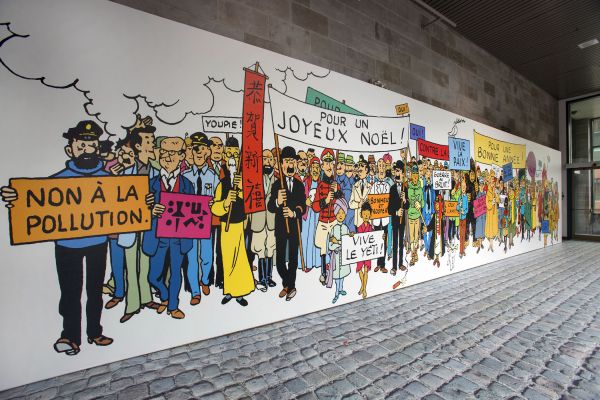One of the highlights of my August visit to Québec City was the Hergé à Québec exhibition at the Musée de la civilisation. The show, which has already made stops in Paris, Geneva, and London, offers a retrospective on the life and work of Georges Prosper Remi (1907 – 1983), better known to children around the world as Hergé, creator of Tintin, intrepid boy reporter, and Snowy, his sardonic canine companion.
Hergé à Québec spans Remi’s entire career, from his first childhood drawings to his late-in-life brush with contemporary art. As a means of introducing Hergé to visitors, the show begins with a gallery of items culled from his formative years, including a comic drawn when he was a sixteen-year-old Boy Scout. This room is followed by a sequence of exhibits exploring three seminal Tintin stories, Tintin in the Land of the Soviets (1930), The Blue Lotus (1932) and Cigars of the Pharoah (1934). Through a series of well-chosen projections, photographs, and pages, the curators define Hergé’s ligne claire (clear line) style, and state the main thesis of the show: that Tintin teaches young readers about the world through his adventures — in which Tintin is subject to the slings and arrows of fortune as he travels through foreign lands — and missions — in which he pursues a specific objective, such as finding a lost object. This idea is further developed in later galleries, culminating in a charming display of pages from and items associated with Tintin’s two lunar adventures: Destination Moon (1953) and Explorers on the Moon (1954).
The show also includes a gallery featuring commercial posters designed by his production company l’Atelier Hergé-Publicité. These advertisements, rendered in a bold, colorful style reminiscent of Cassandre’s, urge consumers to fly Sabena Airlines, read Le Vingtième Siècle, and buy Parein biscuits. As playful and striking as many of these images are, the inclusion of one toy company’s poster — an image of a thick-lipped African child holding an umbrella — points to one of the exhibition’s main flaws: it misses the opportunity to address Hergé’s racist depictions of colonized people in a historically responsible fashion.
In tracing the development of Hergé’s storytelling from Tintin in the Land of the Soviets to The Blue Lotus, the show only tacitly acknowledges the two works that fell between them: Tintin in the Congo (1931) and Tintin in America (1932). Instead, the curators focus on Hergé’s relationship with Chinese artist Zhang Chongren, whom Hergé befriended shortly before writing The Blue Lotus. Through his interactions with Zhang, they argue, Hergé learned the importance of researching the places Tintin visited, rather than defaulting to popular stereotypes about their peoples. And while the discussion of Hergé and Zhang’s friendship offers evidence that Hergé was capable of taking a more nuanced view of other cultures, the show never examines Hergé’s paternalistic view of Belgium’s African subjects, an issue that’s explicitly addressed in both Benoit Peeters’ Hergé: Son of Tintin and Pierre Assouline’s Hergé, The Man Who Created Tintin.
The exhibition does a better job of addressing Hergé’s stint at Le Soir (1939-1944), the official newspaper of occupied Belgium. After the war, Hergé was arrested four times on suspicion of collaborating with the Nazi regime — charges that almost cost him his citizenship. To the curators’ credit, the show includes a brief video interview with Hergé about this episode in his life. By acknowledging his involvement with Le Soir in such a neutral fashion, however, the show misses another opportunity to present a more nuanced picture of Hergé’s political beliefs, warts and all.
Where the show excels is in its ability to immerse the visitor in Hergé’s creative process, from crude storyboards — with cross-outs, arrows, and editorial notes — to published work. Throughout the exhibition, there are numerous pairings of early drafts with finished products, allowing the viewer to trace the development of characters and scenes from concept to completion. The galleries also include several side-by-side comparisons of objects with the images they inspired, most notably in Tintin and the Broken Ear (1937). Although some of these pages are presented in their final form, with word balloons and dialogue, many are not. This decision allows the visitor to more fully appreciate the role of Hergé’s line work and colorful palette in creating Tintin’s world — without the mediating influence of text.
The exhibition also makes a strong case that Hergé deserves serious consideration as both an art collector and painter. The final gallery juxtaposes Hergé’s acquisitions — including Roy Lichtenstein’s Rouen Cathedral (1967) — with his own original canvases. And as fascinating as it was to contemplate Hergé’s taste in art, I found the modernist work that he produced under the tutelage of Belgian painter Louis Van Lint (1909-1986) more striking than the work he’d collected. His own paintings demonstrate strong affinities with Joan Miró and Marc Chagall, but also demonstrate strong affinities with his cartooning, as evidenced by his careful delineation of space and strong sense of color.
It’s a shame that the curators didn’t explore Hergé’s life with the same zeal; doing so would have provided valuable context for understanding him as a product of a specific place and time, immersed in ideas that shaped the characters he created and the stories he told. Yet for all the show’s limitations, Hergé à Québec gave me new insight into Hergé’s evolution as an artist and storyteller, and a deeper appreciation of his craft. For an artist’s perspective on Hergé à Québec, see Ben Towle’s thoughtful evaluation of the exhibit.
Hergé à Québec is on display at the Musée de la civilisation in Quebec City through October 22nd. For information and tickets, click here. Note that the show is not included in the general admission price to the museum.


